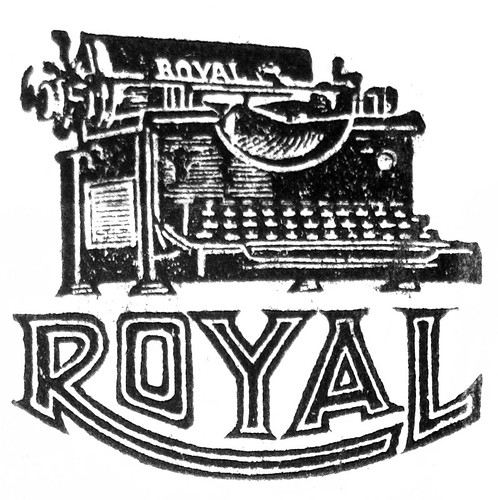- ztyper
- Key Master
 Offline
Offline 
- From: Somewhere in New Jersey
- Registered: 01-10-2014
- Posts: 773
Re: If you could pick one...
TypewriterKing wrote:
Incidentally, do you have such a machine in your collection? If so, what year was it made, and is it a two-er or a four-er?
I've got a '28 specimen with two glass windows. It's the style that I had hoped for because I find the one with two windows to be more streamlined and art-deco while the one with four windows is more art-nouveau especially with the early pin-striping. Still would like an early Royal 10 along with one of the last ones with the segment shift and decimal tabulators to see how the design and function of the Royal 10 evolved over time. Can't really think of another typewriter that underwent a lot of change while still retaining the same name.
And why do all typewriters advertise and have a stencil option if it was rarely ever used? Maybe to help test the re-alignment of type after the sheet's been taken out? (Or at least that's what I do)
A high schooler with a lot of typewriters. That's pretty much about it.
- TypewriterGuy
- Typewriter Talk Vet
 Offline
Offline 
- From: United States
- Registered: 24-4-2015
- Posts: 1,250
Re: If you could pick one...
Hehe, I just got a #10 with pinstripes ![]()
Back from a long break.
Starting fresh with my favorite typer. A Royal Futura!
- Uwe
- Moderator
 Offline
Offline 
- From: Toronto, Canada
- Registered: 12-3-2013
- Posts: 4,410
Re: If you could pick one...
ztyper wrote:
I find the one with two windows to be more streamlined and art-deco while the one with four windows is more art-nouveau especially with the early pin-striping.
The Art Nouveau movement predated Art Deco, and considering its signature use of exaggerated curves, I don't see how it can be applied to the design of a Royal Model 10. Of the top of my head, the only typewriters I can picture that were seemingly influenced by the Art Nouveau movement are the early Ideal models, which first appeared during the height of the design period.
Streamline Moderne was an off-shoot of Art Deco, and again I wouldn't apply this design philosophy to the Model 10 (regardless of the number of glass panels it has).
One characteristic of Art Deco - in terms of architecture - is the use of smaller, more numerous windows, so if anything I'd say the four-panel Royal 10 is more of an Art Deco design than the two-panel model.
ztyper wrote:
And why do all typewriters advertise and have a stencil option if it was rarely ever used? Maybe to help test the re-alignment of type after the sheet's been taken out? (Or at least that's what I do)
It may be rarely used now, but when typewriters were an office mainstay there often was only two ways of producing copies of what was being typed. You either used carbon paper, which limited the number of copies you could make to around five at a time, or you cut a stencil and used a mimeograph to produce a couple of hundred copies.
The pronoun I has always been capitalized in the English language for more than 700 years.
- TypewriterKing
- Inactive Account
 Offline
Offline - From: DeepInTheHeartO', Texas
- Registered: 17-2-2016
- Posts: 1,011
Re: If you could pick one...
Uwe wrote:
The key to the question is the criteria that you can only have one standard. So, are you a serious typist? Or someone who just punches a few keys on occasion? If you're a poser, then any standard you like the look of will do; they all type well enough to satisfy someone who only dabbles in typing. However, if you need a real workhorse, one machine that does it all, is feature laden and performs exceptionally well, then you have to be far more discriminating.
I own all of the models that have been mentioned so far in this thread, and I would choose the Olympia SG1. It's the complete package, period. I can't think of another standard that can match it for features (paper injector, quick carriage release, double character spacing, a FIVE position vibrator, paper rest, touch control, a jammed key release, spring-loaded keys, etc.). Of all the standards that I own it's my go-to machine for getting work done. And there's a reason that there's an SG Owners' Club here, and why it's so popular.
If having typed over 3300 letters to my girlfriend over the last 13 years, along with dozens of letters to the editor of my local newspaper, and a few assignments and tests I have proctored while I was a refrigeration instructor doesn't qualify as serious typing, I guess I'd better hurry up and get a few more pages under my belt. Oh, yes, I would imagine it would help if one had at least a working knowledge of different typewriters, along with different kinds (standard, portable, electric, etc.) of typewriters. Olympia's a fine typewriter, and again, my '56 and 60 models are definitely going to be fixed up. But, again, since I do a lot of typing on a regular basis, I would have to go with my HH Royal. I like the touch and it is an outstandingly well-made machine.
Underwood--Speeds the World's Bidness
- ztyper
- Key Master
 Offline
Offline 
- From: Somewhere in New Jersey
- Registered: 01-10-2014
- Posts: 773
Re: If you could pick one...
Uwe wrote:
It may be rarely used now, but when typewriters were an office mainstay there often was only two ways of producing copies of what was being typed. You either used carbon paper, which limited the number of copies you could make to around five at a time, or you cut a stencil and used a mimeograph to produce a couple of hundred copies.
But why were they on most portables? Not sure about you, but I personally don't own a mimeograph machine and I don't think most people did. Was it just a selling point to make the typewriter appear more "feature-packed" so they could turn more of a profit?
And I might have misspoken before. The first incarnation of the Royal 10 looks more like an early typewriter with all of the pinstripe decals while the second incarnation looks more modern with its chromed lined side windows and more boxy frame which I tend to like more.
A high schooler with a lot of typewriters. That's pretty much about it.
- TypewriterKing
- Inactive Account
 Offline
Offline - From: DeepInTheHeartO', Texas
- Registered: 17-2-2016
- Posts: 1,011
Re: If you could pick one...
ztyper wrote:
Uwe wrote:
It may be rarely used now, but when typewriters were an office mainstay there often was only two ways of producing copies of what was being typed. You either used carbon paper, which limited the number of copies you could make to around five at a time, or you cut a stencil and used a mimeograph to produce a couple of hundred copies.
But why were they on most portables? Not sure about you, but I personally don't own a mimeograph machine and I don't think most people did. Was it just a selling point to make the typewriter appear more "feature-packed" so they could turn more of a profit?
And I might have misspoken before. The first incarnation of the Royal 10 looks more like an early typewriter with all of the pinstripe decals while the second incarnation looks more modern with its chromed lined side windows and more boxy frame which I tend to like more.
I am not sure of the real answer here, ztyper, but yes, capitalism at work here probably. I have cut stencils for one of my High School teachers as late as 1985--although I had the ribbon selector in black position. I was using a 1955 Underwood 150 I built out of about three other typewriters, but it worked well. I ended up selling that one to another High School teacher when I graduated in 1987, which gives you an idea of how old I am. Anyway, it would seem to me that having the ribbon color set to stencil would help to make clearer carbon copies. It would seem that the stencil feature would be a sort of vestigial feature from another time--especially if the typewriter were manufactured when Xerox machines were in offices. And that's been for quite sometime.
Underwood--Speeds the World's Bidness
- TypewriterGuy
- Typewriter Talk Vet
 Offline
Offline 
- From: United States
- Registered: 24-4-2015
- Posts: 1,250
Re: If you could pick one...
ZTyper, also dont forget the desktop typewriters were made for offices and businesses! They were (The 20 models anyways) around $2000 new... The manufacturers had to include the stench option because other companies were using it. Its like a copy machine today. (Well the setting)As for portables, manufactures
Back from a long break.
Starting fresh with my favorite typer. A Royal Futura!
- TypewriterKing
- Inactive Account
 Offline
Offline - From: DeepInTheHeartO', Texas
- Registered: 17-2-2016
- Posts: 1,011
Re: If you could pick one...
TypewriterGuy wrote:
ZTyper, also dont forget the desktop typewriters were made for offices and businesses! They were (The 20 models anyways) around $2000 new... The manufacturers had to include the stench option because other companies were using it. Its like a copy machine today. (Well the setting)As for portables, manufactures
As ztyper said: The stencil feature was found on most portable machines too. Again, I'm thinking this was a vestigial feature from before Xerox machines--and some typewriters--post-Xerox--were fitted with this feature. And as for the price on typewriters, I looked in my NOMDA book the other day, and an IBM Executive (not Selectric) cost, depending on carriage length and typewriter font, anywhere from about $400-$600. Selectrics I have heard cost around $1000. These were new prices on American machines. It is entirely possible there were machines that cost around $2000, and I would be curious to know which ones these were. My guess that there was probably an additional tariff added to an imported American brand or brands of typewriters, I don't know, I'm just guessing at this point.
Underwood--Speeds the World's Bidness
- ztyper
- Key Master
 Offline
Offline 
- From: Somewhere in New Jersey
- Registered: 01-10-2014
- Posts: 773
Re: If you could pick one...
Just looked it up, and $100 (the average price of a standard then) in 1925 was about $1300 in today's cash. So quite a bit of money.
And I know that the stencil option was used in office machines, I was just confused because home portables had them too.
And TypewriterKing, don't worry, my mother is class of 1985, so you're not old at all! ![]()
A high schooler with a lot of typewriters. That's pretty much about it.
- TypewriterKing
- Inactive Account
 Offline
Offline - From: DeepInTheHeartO', Texas
- Registered: 17-2-2016
- Posts: 1,011
Re: If you could pick one...
ztyper wrote:
Just looked it up, and $100 (the average price of a standard then) in 1925 was about $1300 in today's cash. So quite a bit of money.
And I know that the stencil option was used in office machines, I was just confused because home portables had them too.
And TypewriterKing, don't worry, my mother is class of 1985, so you're not old at all!
You're my new best friend!!![]()
Underwood--Speeds the World's Bidness


